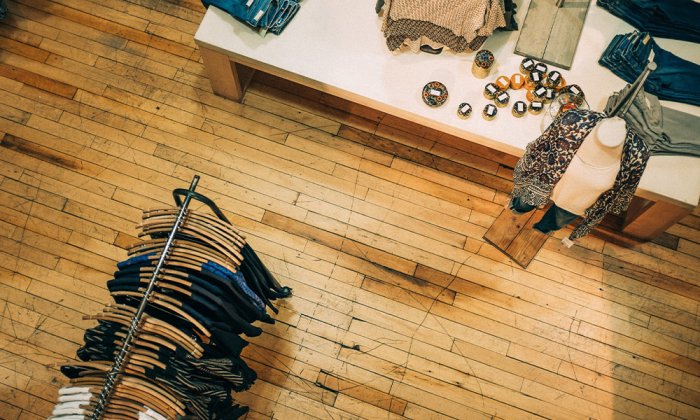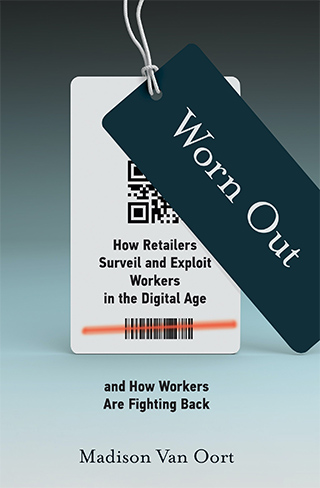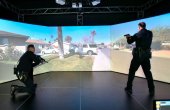How Retailers Surveil and Exploit Workers in the Digital Age

At first glance, fast fashion — a booming sector of the retail industry known for selling colossal amounts of cheap, trendy clothing — might seem mundane, apolitical, or even a distraction from more pressing social issues. But beneath its success, and beyond its well-documented environmental impacts, there is a grimmer story to be told, says sociologist Madison Van Oort.

In researching her book “Worn Out,” Van Oort observed firsthand how data and modern surveillance shape the lives of retail workers — and how these workers are fighting back. In 2014, she took a break from teaching to work undercover in two of the world’s largest fast fashion stores in New York City. During that time, she attended industry trade shows, where she observed tech companies peddling their latest retail management and surveillance products — fortifying an already close partnership with law enforcement — and interviewed dozens of front line employees, retail labor organizers, and activists.
The result is one of the first ethnographies of this thriving industry, one that bridges exposés of garment manufacturing and the environmental impacts of mounting clothing waste and pulls open the curtain between production and consumption. We asked Van Oort about her findings and what fast-fashion retail can teach us about the future of work.
A few years ago, you took a step back from teaching to immerse yourself in the world of retail. What surprised you most about that experience? Why do you think retail work feels more grueling than ever?
When I attempted to enter the field myself, I was surprised by just how difficult it was to land a job. Less important than my work history or customer service skills was my schedule. Nearly every retailer I applied to requested “open availability.”
The interview process itself was extremely unpredictable, usually requiring two to three rounds of interviews. You’re warned that you might be contacted to come back for subsequent interviews the next day — or in a month. When one is hoping to pay bills with that job, waiting up to a month can seem like eternity. If you missed an interview for whatever reason, you were out of the running. The fact that these retailers, which offer low pay and few if any benefits, expect applicants to put themselves through that to prove their open availability, was shocking to me.
The interviews themselves were quite grueling too, much more than I would expect for an entry-level job. Some lasted multiple hours and involved a lot of role-playing. But they were ultimately indicative of how stressful the work was.
Once hired, the daily tasks of retail workers have shifted to focusing almost exclusively on the inventory: unpacking clothes, putting them on display tables and clothing racks, tidying displays that quickly become disheveled by customers, and returning items to their proper locations after coming out of the fitting room. When items turn over so quickly and the number of different items for sale is so gargantuan, figuring out where something goes can feel like a Sisyphean task.
That’s compounded and made more stressful by employers controlling workers’ time when they’re not even on the clock, something you cover extensively in the book. Could you give a few examples of how employers are using data and surveillance technologies to accomplish this?
There are three primary ways retail employers use data and surveillance technologies to control workers’ time outside of work.
First and most obviously is through automated, just-in-time scheduling. Retailers use scheduling software that runs an algorithm to determine exactly how many and how few workers are needed at any given moment. As investigative journalist Esther Kaplan writes, the rise of this software led many retailers to transition from a full-time workforce to one that’s primarily part-time.
Workers never know what their schedules will be or how many hours they’ll work from week to week. This makes it impossible to make long-term plans outside of work or have any sense of financial stability. By the time I was in the industry, labor organizers had helped achieve bans on on-call scheduling and “clopening” shifts, which is when someone is scheduled for a closing shift one day and an opening shift the next day. But despite these formal bans, I often felt like I was on-call.
For example, our managers would regularly ask if we “wanted” to leave early or stay late, and my manager called me at home several times to ask if I wanted to come in and take an extra shift that same day. When I would decline, he responded with annoyance and aggression. If just-in-time labor bolstered the company’s bottom line, it added stress for both front-line staff and managers.
A second way is through biometric time clocks in which employees clock in and out by scanning their fingerprints. These digital clocks are especially important to retailers since the shift to automated scheduling means managers cannot conceivably keep track of all the employees coming and going throughout the day (I remember some managers asking passersby, “Do you still work here?”).
These clocks are sold to retailers on the promise of preventing “time stealing,” which is when workers attempt to get paid for time not worked. But because large retailers often require employees to go through security checks to make sure they’re not pilfering any products, this can add up to several minutes of unpaid time between clocking out and actually leaving the store. Some class action lawsuits have attempted to address this issue.
And, although I didn’t experience this myself, one worker I interviewed said their employer strongly encouraged them to download and check Slack for updates from their managers. Of course, since the pandemic, Slack has become a ubiquitous white-collar collaboration tool. But it could be another instance of wage theft when required of hourly employees outside of their working hours.
The third example is the rise of social media and app-based surveillance. I was warned of managers who friended their employees on social media and had the employees reprimanded or fired if their social media posts implied they lied about reasons for taking time off work.
Related to this, some third-party companies claim to aggregate social media posts about given retail locations to generate “risk scores” that could supposedly help retailers allocate their security resources. Posts like “I hate my job” are considered negative sentiments that would increase a location’s risk score. Higher risk scores mean more loss prevention resources and more potential points of connection between employees and law enforcement. This could ultimately discourage employees from speaking out against harms they experience by their employer.
Were the employees you interviewed aware of all the ways they were being monitored?
Yes and no. Some monitoring technologies were visible to employers, like the biometric time clocks and closed-circuit television cameras. But many others were less visible.
In one telling instance, I was being trained on the cash register. The employee training me told me there was a simple button I could use to correct errors in my transactions and that I could use this button as often as I wished. But soon after she said that, our manager spun to her and said, in seriousness, “You know we track that, right?” The employee’s eyes transformed into saucers; she was terrified.
In another case, one of my interviewees told me that he once put five dollars — half an hour’s wages — from his own pocket into the register when his drawer came up short; being reprimanded for previous mistakes, he said, had been “terrifying.” Another interviewee told me: “The rule with them is, if you’re under anything more than $75, it’s automatic termination. If you have someone under $40 it might not be their fault. It’s an honest, slight mistake. But they’d still fire them because they’d see it as they’d have the potential to do it again.”
When I interviewed workers, they sometimes seemed nonchalant about being tracked, given the ubiquity of surveillance across society. Some seemed to not even want to know more information. But these examples illustrate how worker monitoring can increase workers’ sense of insecurity in a context of big data surveillance: While they might not be aware of exactly how they are being monitored, they know being even a few dollars off is a risk they can’t afford to take, especially when they are both trying to pay their way through school and their labor power is easily replaceable.
In a chapter on the digitization of work, you quote a Bloomberg Business report that describes the secret to fast fashion’s success as “more data, fewer bosses.” How are companies leveraging online customer shopping and browsing information, and how is that practice impacting customers and employees?
Solon Barocas and Karen Levy talk about this phenomenon they call “refractive surveillance,” in which the data collection about one group of people can impact another. They describe how in the retail sector technologies built to track customer movements throughout stores required new ways to distinguish customers from employees, thus leading to more digital scrutiny of workers’ movements as well.
Another example is how retailers rely on point-of-sale data and customer trend data to determine the inventory across different retail locations. On the one hand, we could say this shift has served customers well by providing them more of what they want when they want it.
But it is also what led to a shift away from interactive customer service that I described earlier. In-store employees no longer need to build relationships with customers; the data paint a more detailed picture of consumer habits and desires than individual store associates ever could.
To see how this impacts customers, one need only take a look at Google reviews. Lack of customer service abounds, but this isn’t enough to keep people from coming back. As my co-workers often reminded me, “the clothes are so cheap, they sell themselves.”
My favorite chapter in the book begins with a trip to the nation’s largest annual “loss prevention” conference, NRF Protect, where retailers go to buy the latest surveillance technologies. In a breakout session, one rep from a shoe retailer implored the audience to “take your local police chief out for lunch. It could be the best thing you do.” But there were several other overt connections made between retail and police at the conference. Can you talk about that relationship and describe some of the other breakout sessions and your interactions with vendors?
The connections between tech, retail, and law enforcement were incredibly pervasive at this conference.
One of the first vendor booths I encountered invited participants to take a photo with props in front of a backdrop and post it online with the company’s hashtag. That in itself is pretty innocuous, but the backdrop was of a criminal lineup and the props included cards that said things like, “I plead the 5th!” and, “They did it!”
This was one of the most overt examples in which the vendor gimmicks attempted to use humor to create distance between the conference attendees and the very serious consequences of being targeted by these products.
Throughout the conference, vendors highlighted and even flaunted how many of the tools that today are used for commercial spaces were pioneered for law enforcement or the military. One vendor I spoke to told me about how their company created a database in which members (which currently consisted of around 60 major retailers) would enter information regarding employee theft or dishonesty. Then, retailers hiring new employees could run their background checks through this database. As the vendor told me: “The way we set it up is, you have to be a member of the association, and you have to provide the data. And we then just house it and maintain it.”
These digital information warehouses blatantly bypass “ban the box” laws put in place to prevent employers from including questions about criminal history on applications, allowing workers’ pasts to haunt them and impact their future life chances.
I also encountered several facial recognition products, which have grown increasingly common in retail settings. I asked one vendor if people inside the retail stores consent to the use of facial recognition. “Well, I hope so,” he responded. “We just provide the technology. We can’t control what people do with it.” This is especially concerning given that research shows facial recognition technologies are persistently biased against people of color, women, and trans and nonbinary people.
In casual conversations and in breakout sessions, people spoke repeatedly of catching “bad guys,” referring to employees. This framework served to stoke fear among conference participants and dehumanize people who might be targets of these products.
Beyond that, the exhibition hall housed what they called a “fusion center” where conference attendees could mingle with representatives from law enforcement agencies around the country. Readers might recall that “fusion centers” usually refer to intelligence-sharing spaces created by the U.S. Department of Homeland Security following the September 11th attacks.
Taken together, this conference made clear how monitoring of low-wage workers isn’t just an issue of exploitation, it’s connected to broader issues of surveillance and policing across society. That means that alternatives to our contemporary world of retail need to consider not just different ways of working, but different approaches to safety as well.
You argue that retail is an innovative site of social struggle for gender, race, and economic justice. In fact, the final chapter of the book considers how the story of fast-fashion workers relates to broader social movements and describes what groups such as the Retail Action Project and BLM are doing at the intersection of low-wage work, surveillance, and policing. Can you describe some of that work and its impact on the industry?
The Retail Action Project (RAP) is a workers’ center based in New York City. In 2015, I went with them to the National Retail Federation’s annual “Big Show” conference, where retail leaders networked and gave presentations about the industry, and tech companies attempted to sell retailers their latest products.
Inside the bustling conference center, RAP dropped a banner and chanted, and then after being escorted out, gave speeches outside the center, demanding $15 an hour for retail workers. A few RAP members held a banner of cut-out letters that said “I have a dream.” That action took place on Martin Luther King Jr. day, very clearly invoking the lineage between civil rights and workers’ movements.
At the time, many of the organizers and activists involved in the Retail Action Project were fighting to raise the minimum wage during the day and participating in the Black Lives Matter movements in their off hours. It’s no surprise, since people who work in retail are often members of populations regularly targeted by police; these struggles are directly connected.
The ties between these movements also played out powerfully at the Mall of America protests in 2014 and 2015. In Minneapolis, the Mall of America is such an important cultural and economic touchstone that filling it up and halting business as usual gained a lot of attention. Among the photos from that day are some of Lush Cosmetics employees who stood outside their store, fists raised in solidarity.
Afterward, the ACLU brought to light that the company Geofeedia (which geo-targeted social media posts) had been offering to support law enforcement in surveilling protesters.
One of the videos on their website at the time (it’s since been removed) celebrated how it detected an Instagram post of a young Black man wearing a Nickelodeon Universe t-shirt posting about smoking marijuana before going to work at the Mall of America amusement park. The company was able to determine the location of the Instagram poster and apprehend him before his shift. There’s no discussion of what happened upon apprehension, nor any discussion about how the Mall also houses an outpost of the local police department.
These examples made clear how workers’ movements and anti-policing and surveillance movements share significant political territory and history, and I’m excited to see this cross-pollination continue.
I often come back to a quote from surveillance scholar Arun Kundnani; at the 2018 Subverting Surveillance Conference, he said, “the antagonism of surveillance is not privacy, but the making of communities in struggle.” If retail, tech, and law enforcement are intertwined, our liberation movements need to be as well.
Lastly, what do you think fast-fashion retail can teach us about the future of work?
Often, the “future of work” implies a dystopian future in which workers lose their jobs — and, ultimately, their individual and collective agency — to new technologies. But fast fashion retail teaches us that the relationship between workers, employers, and technology is constantly in flux, and that the future is not foreclosed. In fast fashion, and across many other industries, workers are fighting back and using digital technologies to advance their struggles. Fast fashion teaches us that the future of work can in fact be refashioned toward more liberatory ends.



